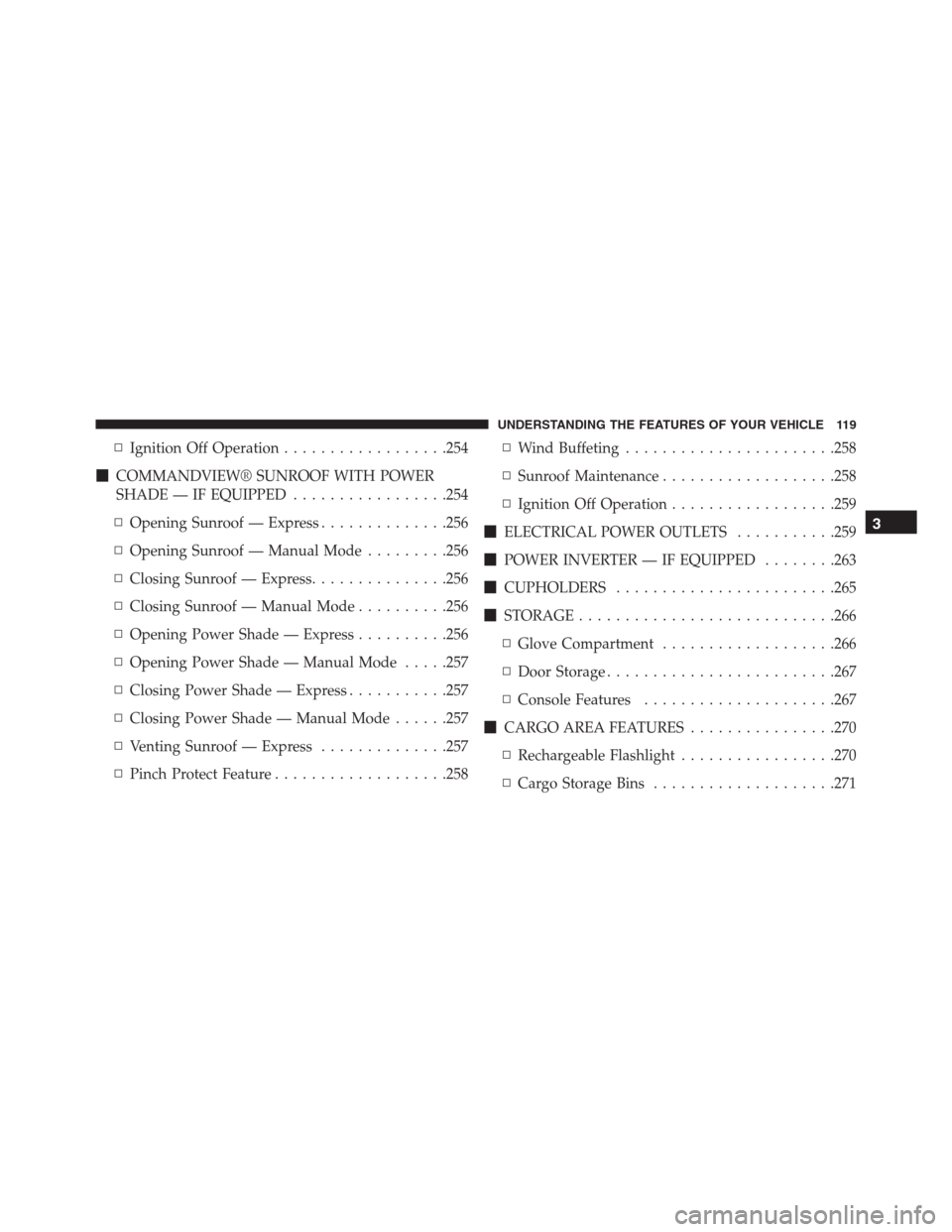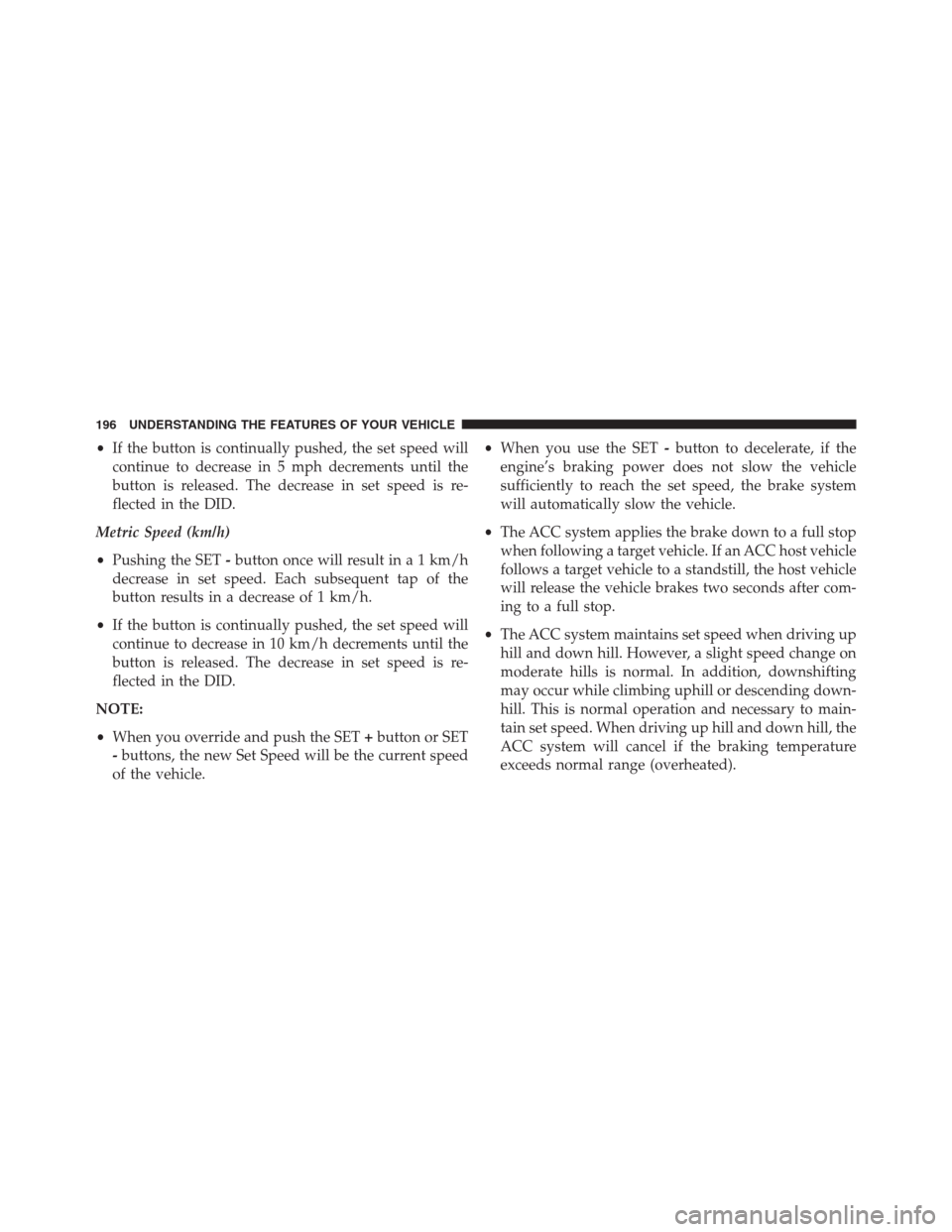Page 111 of 636

The best protection against carbon monoxide entry into
the vehicle body is a properly maintained engine exhaust
system.
Whenever a change is noticed in the sound of the exhaust
system, when exhaust fumes can be detected inside the
vehicle, or when the underside or rear of the vehicle is
damaged, have a competent mechanic inspect the com-
plete exhaust system and adjacent body areas for broken,
damaged, deteriorated, or mispositioned parts. Open
seams or loose connections could permit exhaust fumes
to seep into the passenger compartment. In addition,
inspect the exhaust system each time the vehicle is raised
for lubrication or oil change. Replace as required.Safety Checks You Should Make Inside The
Vehicle
Seat Belts
Inspect the seat belt system periodically, checking for
cuts, frays, and loose parts. Damaged parts must be
replaced immediately. Do not disassemble or modify the
system.
Front seat belt assemblies must be replaced after a
collision. Rear seat belt assemblies must be replaced after
a collision if they have been damaged (i.e., bent retractor,
torn webbing, etc.). If there is any question regarding seat
belt or retractor condition, replace the seat belt.
Air Bag Warning Light
The light should come on and remain on for
four to eight seconds as a bulb check when the
ignition switch is first turned ON. If the light is
2
THINGS TO KNOW BEFORE STARTING YOUR VEHICLE 109
Page 118 of 636

�HEATED STEERING WHEEL — IF EQUIPPED . .182
�ELECTRONIC SPEED CONTROL — IF
EQUIPPED...........................183
▫To Activate..........................184
▫To Set A Desired Speed.................184
▫To Deactivate........................185
▫To Resume Speed.....................185
▫To Vary The Speed Setting...............185
▫To Accelerate For Passing...............186
�ADAPTIVE CRUISE CONTROL (ACC) — IF
EQUIPPED...........................187
▫Adaptive Cruise Control (ACC) Operation. . . .189
▫Activating Adaptive Cruise Control (ACC). . . .190
▫To Activate/Deactivate..................191▫To Set A Desired ACC Speed.............192
▫To Cancel...........................193
▫ToTurnOff..........................193
▫To Resume..........................194
▫To Vary The Speed Setting...............194
▫Setting The Following Distance In ACC......197
▫Overtake Aid........................201
▫ACC Operation At Stop.................201
▫Adaptive Cruise Control (ACC) Menu.......202
▫Display Warnings And Maintenance........203
▫Precautions While Driving With ACC.......206
▫General Information...................210
116 UNDERSTANDING THE FEATURES OF YOUR VEHICLE
Page 120 of 636

▫ParkSense® System Usage Precautions.......235
�PARKVIEW® REAR BACK UP CAMERA — IF
EQUIPPED...........................237
�OVERHEAD CONSOLE..................240
▫Front Map/Reading Lights — If Equipped . . .240
▫Courtesy Lights.......................241
▫Sunglasses Bin Door...................242
�GARAGE DOOR OPENER — IF EQUIPPED . . .242
▫Before You Begin Programming HomeLink® . .243
▫Programming A Rolling Code.............244
▫Programming A Non-Rolling Code.........246
▫Canadian/Gate Operator Programming......247
▫Using HomeLink®....................249▫Security............................249
▫Troubleshooting Tips...................249
▫General Information....................250
�POWER SUNROOF — IF EQUIPPED........251
▫Opening Sunroof — Express..............252
▫Opening Sunroof — Manual Mode.........252
▫Closing Sunroof — Express...............252
▫Closing Sunroof — Manual Mode..........252
▫Pinch Protect Feature...................253
▫Venting Sunroof — Express..............253
▫Sunshade Operation....................253
▫Wind Buffeting.......................253
▫Sunroof Maintenance...................254
118 UNDERSTANDING THE FEATURES OF YOUR VEHICLE
Page 121 of 636

▫Ignition Off Operation..................254
�COMMANDVIEW® SUNROOF WITH POWER
SHADE — IF EQUIPPED.................254
▫Opening Sunroof — Express..............256
▫Opening Sunroof — Manual Mode.........256
▫Closing Sunroof — Express...............256
▫Closing Sunroof — Manual Mode..........256
▫Opening Power Shade — Express..........256
▫Opening Power Shade — Manual Mode.....257
▫Closing Power Shade — Express...........257
▫Closing Power Shade — Manual Mode......257
▫Venting Sunroof — Express..............257
▫Pinch Protect Feature...................258▫Wind Buffeting.......................258
▫Sunroof Maintenance...................258
▫Ignition Off Operation..................259
�ELECTRICAL POWER OUTLETS...........259
�POWER INVERTER — IF EQUIPPED........263
�CUPHOLDERS........................265
�STORAGE............................266
▫Glove Compartment...................266
▫Door Storage.........................267
▫Console Features.....................267
�CARGO AREA FEATURES................270
▫Rechargeable Flashlight.................270
▫Cargo Storage Bins....................271
3
UNDERSTANDING THE FEATURES OF YOUR VEHICLE 119
Page 158 of 636
WARNING!(Continued)
collision. Always make sure the outboard head re-
straints are in their upright positions when the seat is
to be occupied.
NOTE:For proper routing of a Child Seat Tether, refer to
“Occupant Restraints” in “Things to Know Before Start-
ing Your Vehicle” for further information.
60/40 Split Rear Seat
To Lower Rear Seat
Either side of the rear seat can be lowered to allow for
extended cargo space and still maintain some rear seating
room.
NOTE:Be sure that the front seats are fully upright and
positioned forward. This will allow the rear seatback to
fold down easily.1. Pull upward on the release lever to release the seat.
NOTE:
•Do not fold the 60% rear seat down with the left
outboard or rear center seat belt buckled.
•Do not fold the 40% rear seat down with the right
outboard seat belt buckled.
Rear Seat Release
156 UNDERSTANDING THE FEATURES OF YOUR VEHICLE
Page 189 of 636

Using Electronic Speed Control On Hills
The transmission may downshift on hills to maintain the
vehicle set speed.
NOTE:The Electronic Speed Control system maintains
speed up and down hills. A slight speed change on
moderate hills is normal.
On steep hills, a greater speed loss or gain may occur so
it may be preferable to drive without Electronic Speed
Control.
WARNING!
Electronic Speed Control can be dangerous where the
system cannot maintain a constant speed. Your ve-
hicle could go too fast for the conditions, and you
could lose control and have an accident. Do not use
Electronic Speed Control in heavy traffic or on roads
that are winding, icy, snow-covered or slippery.
ADAPTIVE CRUISE CONTROL (ACC) — IF
EQUIPPED
Adaptive Cruise Control (ACC) increases the driving
convenience provided by cruise control while traveling
on highways and major roadways. However, it is not a
safety system and not designed to prevent collisions.
Electronic Speed Control function performs differently.
Please refer to the proper section within this chapter.
ACC will allow you to keep cruise control engaged in
light to moderate traffic conditions without the constant
need to reset your cruise control. ACC utilizes a radar
sensor and a forward facing camera designed to detect a
vehicle directly ahead of you.
NOTE:
•If the sensor does not detect a vehicle ahead of you,
ACC will maintain a fixed set speed.
3
UNDERSTANDING THE FEATURES OF YOUR VEHICLE 187
Page 190 of 636

•If the ACC sensor detects a vehicle ahead, ACC will
apply limited braking or acceleration (not to exceed
the original set speed) automatically to maintain a
preset following distance, while matching the speed of
the vehicle ahead.
The Cruise Control system has two control modes:
•Adaptive Cruise Control mode for maintaining an
appropriate distance between vehicles.
•Normal (fixed speed) electronic speed control mode
for cruising at a constant preset speed. For additional
information, refer to “Normal (Fixed Speed) Cruise
Control Mode” in this section.
NOTE:Normal (fixed speed) electronic speed control
will not react to preceding vehicles. Always be aware of
the mode selected.You can change the mode by using the Cruise Control
buttons. The two control modes function differently.
Always confirm which mode is selected.
WARNING!
•Adaptive Cruise Control (ACC) is a convenience
system. It is not a substitute for active driving
involvement. It is always the driver ’s responsibil-
ity to be attentive of road, traffic, and weather
conditions, vehicle speed, distance to the vehicle
ahead; and, most importantly, brake operation to
ensure safe operation of the vehicle under all road
conditions. Your complete attention is always re-
quired while driving to maintain safe control of
your vehicle. Failure to follow these warnings can
result in a collision and death or serious personal
injury.
(Continued)
188 UNDERSTANDING THE FEATURES OF YOUR VEHICLE
Page 198 of 636

•If the button is continually pushed, the set speed will
continue to decrease in 5 mph decrements until the
button is released. The decrease in set speed is re-
flected in the DID.
Metric Speed (km/h)
•Pushing the SET-button once will result in a 1 km/h
decrease in set speed. Each subsequent tap of the
button results in a decrease of 1 km/h.
•If the button is continually pushed, the set speed will
continue to decrease in 10 km/h decrements until the
button is released. The decrease in set speed is re-
flected in the DID.
NOTE:
•When you override and push the SET+button or SET
-buttons, the new Set Speed will be the current speed
of the vehicle.•When you use the SET-button to decelerate, if the
engine’s braking power does not slow the vehicle
sufficiently to reach the set speed, the brake system
will automatically slow the vehicle.
•The ACC system applies the brake down to a full stop
when following a target vehicle. If an ACC host vehicle
follows a target vehicle to a standstill, the host vehicle
will release the vehicle brakes two seconds after com-
ing to a full stop.
•The ACC system maintains set speed when driving up
hill and down hill. However, a slight speed change on
moderate hills is normal. In addition, downshifting
may occur while climbing uphill or descending down-
hill. This is normal operation and necessary to main-
tain set speed. When driving up hill and down hill, the
ACC system will cancel if the braking temperature
exceeds normal range (overheated).
196 UNDERSTANDING THE FEATURES OF YOUR VEHICLE